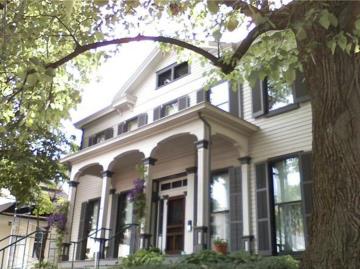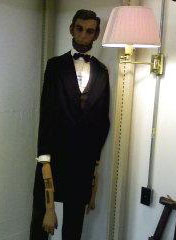


© 2014 Robert McKercher. All rights reserved.


Vachel Lindsay Walks at Midnight
During the summer of 2010, I interned with the Illinois Historic Preservation Agency (IHPA) in the state capital, Springfield. I processed a collection of archival materials that had remained untouched since its donation by the Vachel Lindsay Association (VLA) in 2009. It was often tedious, dirty work, but there were also moments of excitement, such as my discovery of what may be a previously unpublished poem handwritten on hotel stationary (Lindsay historian Dennis Camp is still researching it).
It was a rewarding experience, not only because I had the opportunity to be the first person in decades to recognize the significance of the items in the collection, but also as a sightseeing trip. IHPA's offices were in the Old State Capitol building, which is now a state historic site preserved as it appeared in 1860, and I received private, behind-the-scenes tours of the state archives, the Abraham Lincoln Presidential Library and Museum, and the Vachel Lindsay House, which IHPA operates as a state historic site.
Springfield native Vachel Lindsay was a poet and artist who became internationally famous in the early twentieth century. His most famous works today are likely “Abraham Lincoln Walks at Midnight (in Springfield, Illinois)” and “The Congo.” In the film The Dead Poets Society, the protagonists chant “The Congo” as they leave the cave where they’ve just had their meeting. This is fitting, as Lindsay intended most of his work to be sung or chanted. In the 1910s he was known as the Prairie Troubadour because he spent years travelling the country on foot trading poems for food. Lindsay committed suicide in December 1931; the non-profit Vachel Lindsay Association formed 15 years later to preserve both his memory and Lindsayiana. The “-iana” suffix is an archival affectation meaning tactile stuff associated with a particular subject. In this case, Lindsayiana includes the usual documents and photos as well as the Vachel Lindsay House itself.
Because of limited resources, the VLA donation had been untouched since IHPA received it. When I started, it was just stacks of yellowed cardboard boxes in the Old State Capitol basement. My task was to transfer items into archival storage, determine the collection’s size and scope, and to inventory the contents as a roadmap for future arrangement and description. After “weeding” (an archival term for removal of duplicates and unaffiliated materials), the collection ended up as approximately 50 linear feet of paper, photographs, and three dimensional objects (a linear foot is document storage measurement equal to 12 inches for documents stored on edge or 12 inches high for documents stored horizontally).
Six Weeks in Springfield, Illinois
The Vachel Lindsay House, a Greek Revival home built in 1879 by Lindsay's father, viewed from South Fifth Street, Springfield, Illinois. Lindsay was born in the house, lived much of his life there, and died there. The house was declared a National Historic Landmark in 1971. The Illinois Historic Preservation Agency restored the house in 2001 and now operates it as a state historic site. Photo by Robert McKercher.
Vachel Lindsay House Interiors.
Around Springfield.
Some of the collection’s highlights were Lindsay’s mother’s travel journals, stock certificates, legal documents relating the Lindsay home, and the aforementioned handwritten poem. There was a great letter from Lindsay’s widow to a family friend in which she roasts Edgar Lee Masters’ posthumous biography of her husband. There was also a series of letters in which the VLA scolds Springfield’s city leaders for caving in to protests over a proposed speaking engagement by Langston Hughes.
At left is the terrifying, deformed Abraham Lincoln mannequin that confronted me each morning outside the elevator in the otherwise uninhabited basement. Photo by Robert McKercher.
Photos by Robert McKercher.
Photos by Robert McKercher.






























